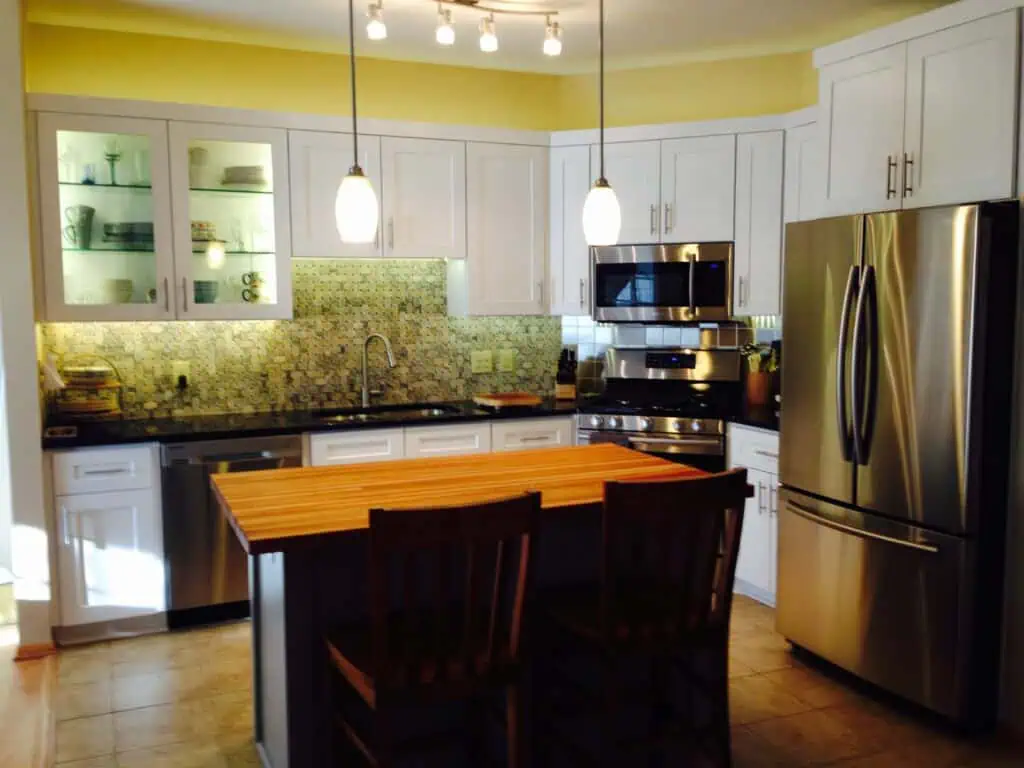Picture this: You’re hosting a dinner party, effortlessly stirring a simmering pot while chatting with friends lounging on the sofa just a few feet away. The aroma of your signature dish wafts through the air, mingling with laughter and conversation. This seamless blend of cooking and socializing is the magic of an open concept kitchen – a space that’s revolutionizing how we think about the heart of our homes.
As a seasoned remodeler, I’ve seen countless kitchens transform from isolated cooking zones to vibrant, multifunctional spaces that bring families and friends together. If you’re considering taking the plunge into open concept living, you’re in for an exciting journey. Let’s explore how you can create a kitchen that’s not just a place to cook, but a central hub for your home life.
Embracing the Open Concept: More Than Just a Trend
An open concept kitchen isn’t just about knocking down walls; it’s about creating a lifestyle that promotes connection and flexibility. Here’s why homeowners are falling in love with this design approach:
- A Brighter, More Spacious Feel: Remember that small, dark kitchen that felt like a cave? By removing walls, natural light floods in, making even modest homes feel significantly larger and more inviting.
- The Social Kitchen: Gone are the days when the cook was exiled to a separate room. Now, you can whip up your famous lasagna while helping the kids with homework or catching up with your partner about their day.
- Improved Flow and Functionality: Moving between cooking, dining, and living areas becomes a breeze. Imagine carrying that hot casserole from oven to table without navigating through doorways!
- Versatility for Modern Living: Open concepts adapt to your needs, whether you’re hosting a large gathering or enjoying a quiet family night in.
Planning Your Dream Open Concept Kitchen: Where to Begin?
Creating the perfect open concept kitchen is like composing a symphony – every element needs to harmonize. Here’s how to start your planning process:
The Kitchen Work Triangle: Your Efficiency Cornerstone
Ever heard of the kitchen work triangle? It’s a time-tested design principle that places the refrigerator, stove, and sink in a triangular layout. This arrangement minimizes unnecessary steps, making cooking more efficient and enjoyable. In an open concept, we adapt this principle to suit your space while maintaining its functionality.
Pro Tip: Measure the distance between these three points. Ideally, the sum of all three sides of the triangle should be between 13 and 26 feet. This ensures everything is within reach without feeling cramped.
Defining Work Zones: A Place for Everything
Think about your cooking process. You’ll want designated areas for:
- Food Prep: A spacious countertop near the sink for chopping and mixing.
- Cooking: Ample space around the stove for hot dishes and cooking utensils.
- Cleaning: A zone around the sink and dishwasher for easy cleanup.
- Storage: Thoughtfully placed cabinets and pantry space to keep everything at your fingertips.
By clearly defining these zones, you’ll create a kitchen that flows naturally, making cooking feel less like a chore and more like a joy.
Traffic Flow: The Dance of Daily Life
Imagine your kitchen during a busy morning routine or a holiday gathering. How do people move through the space? Ensure there’s enough room for multiple cooks to work without bumping elbows, and create clear pathways to other areas of the home. A good rule of thumb is to allow at least 42 inches between counters for primary walkways.
Choosing the Right Appliances and Fixtures: Form Meets Function
In an open concept kitchen, your appliances and fixtures aren’t just functional items – they’re part of your home’s visual landscape. Here’s how to make smart choices:
Size and Placement: Finding the Perfect Fit
The key is balance. A massive professional-grade range might be your dream, but will it overwhelm your space? Consider these factors:
- Scale: Choose appliances that fit the proportions of your kitchen. In smaller spaces, consider apartment-sized or counter-depth models.
- Visual Impact: Since your kitchen is now visible from living areas, opt for appliances with attractive finishes that complement your overall design.
- Functionality: Think about how you cook. A double oven might be essential for the avid baker, while a large refrigerator could be crucial for a family that loves to entertain.
Lighting: Setting the Mood and Illuminating Tasks
Lighting in an open concept kitchen needs to be versatile. You’ll want to create a layered lighting plan that includes:
- Task Lighting: Under-cabinet lights or pendant lights over an island ensure you can see what you’re doing when preparing meals.
- Ambient Lighting: Recessed lights or a central fixture provide overall illumination.
- Accent Lighting: Use spotlights or LED strips to highlight design features or create atmosphere.
Pro Tip: Install dimmer switches to easily transition from bright task lighting to a softer ambiance for dining or entertaining.
Cabinetry and Countertops: The Backbone of Your Kitchen
Your cabinets and countertops play a dual role in an open concept kitchen – they need to be both functional and aesthetically pleasing. Consider these options:
- Cabinets: Two-toned cabinets are trending, allowing you to add visual interest while defining spaces. For example, you might choose white upper cabinets for a light, airy feel, and darker lower cabinets for a grounded look.
- Countertops: Durable materials like quartz or granite stand up to heavy use while offering a wide range of colors and patterns to complement your design.
- Islands: A well-designed island can serve as additional workspace, storage, and a casual dining area. Consider adding electrical outlets and a prep sink to maximize functionality.
Design Elements: Creating a Cohesive Look
The beauty of an open concept kitchen lies in how it blends with adjacent living spaces. Here’s how to create a seamless transition:
Color and Texture: Unifying Your Space
Use a consistent color palette throughout your open area to create visual harmony. This doesn’t mean everything needs to match exactly – think complementary tones and textures. For example:
- Choose a neutral base color for walls and large surfaces, then add pops of color through accessories or a feature wall.
- Repeat textures or materials in different areas. The wood tone of your kitchen cabinets could be echoed in living room furniture or shelving.
Flooring: Defining Spaces Subtly
While consistent flooring can make your space feel larger, you can use subtle changes to define different areas:
- Use the same material throughout, but change the pattern or direction in the kitchen area.
- Opt for durable, easy-to-clean options like tile or luxury vinyl in the kitchen, transitioning to warmer materials like hardwood in living areas.
Incorporating Natural Light: Bringing the Outdoors In
Maximize natural light to make your space feel larger and more inviting:
- Consider enlarging existing windows or adding skylights.
- Use sheer window treatments to maintain privacy without blocking light.
- Position mirrors strategically to reflect light and create the illusion of more space.
Functional Considerations: Making Your Kitchen Work for You
Smart Storage Solutions: A Place for Everything
With fewer walls, creative storage becomes essential. Consider these ideas:
- Floor-to-ceiling cabinets maximize vertical space.
- Deep drawers for pots and pans make access easier.
- A pantry with pull-out shelves keeps everything organized and accessible.
- Open shelving for frequently used items or decorative pieces adds visual interest.
Ventilation: Keeping Your Space Fresh
Proper ventilation is crucial in an open concept to prevent cooking odors from permeating living areas:
- Invest in a powerful, quiet range hood that complements your design.
- Consider a downdraft ventilation system for island cooktops.
- If possible, include windows that can open for natural cross-ventilation.
Noise Reduction: Creating a Peaceful Environment
Open concepts can amplify sounds, but there are ways to minimize noise:
- Choose appliances designed for quiet operation.
- Use sound-absorbing materials like cork flooring or fabric window treatments.
- Consider adding a soft close feature to cabinet doors and drawers.
Trending Features in Open Concept Kitchens
Stay ahead of the curve with these popular additions:
Smart Technology: The Kitchen of the Future
- Voice-activated faucets and lighting controls for hands-free operation.
- Smart refrigerators that can help with grocery lists and meal planning.
- Connected ovens that can be preheated remotely from your smartphone.
Sustainable Choices: Eco-Friendly and Stylish
- Energy-efficient appliances that reduce your carbon footprint and utility bills.
- Recycled glass countertops or reclaimed wood features for unique, environmentally conscious design.
- Low-VOC paints and finishes for better indoor air quality.
Multifunctional Spaces: Adapting to Your Lifestyle
- Kitchen islands with built-in charging stations and homework areas.
- Flexible seating options that can expand for gatherings or contract for daily use.
- Hidden appliances behind cabinet panels for a seamless look when not in use.
Bringing Your Vision to Life: Next Steps
Creating your perfect open concept kitchen is an exciting journey. Here are some final tips to ensure success:
- Visualize Your Space: Use online design tools or work with a professional to create 3D renderings of your new kitchen.
- Set a Realistic Budget: Factor in not just materials and labor, but also potential structural changes and upgrades to electrical or plumbing systems.
- Plan for the Future: Choose timeless design elements that will grow with your family and stand the test of time.
- Don’t Overlook the Details: Small touches like unique hardware or a statement light fixture can elevate the entire space.
- Seek Expert Advice: Consult with a kitchen designer or contractor to ensure your vision is both beautiful and practical.
Remember, an open concept kitchen is more than just a renovation – it’s a transformation of your living space and potentially your lifestyle. By carefully considering layout, design elements, functionality, and current trends, you can create a kitchen that not only meets your needs but becomes the true heart of your home – a place where cooking, conversation, and connection flourish.
So, are you ready to open up your kitchen and your home to new possibilities? The journey to your dream open concept kitchen starts now. Happy planning!

